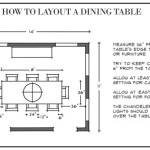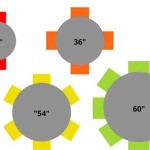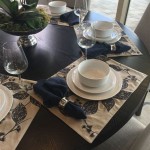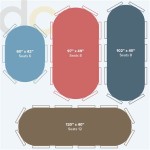Quilted Table Runner Ideas: Enhancing Your Tabletop Decor
Quilted table runners offer a versatile and visually appealing way to enhance tabletop décor. They provide a layer of protection for the table surface, add texture and color to the dining area, and can reflect personal style or seasonal themes. The creation of a quilted table runner allows for endless customization, making it possible to craft a unique piece that perfectly complements any home.
The design possibilities for quilted table runners are vast. From traditional patchwork designs to modern geometric patterns, the choices are limited only by imagination and skill. The selection of fabrics, colors, and quilting techniques contributes significantly to the overall aesthetic. This article explores various quilted table runner ideas to inspire creativity and assist in planning a successful quilting project.
Fabric Selection and Color Palette
The foundation of any quilted project lies in the choice of fabrics. For table runners, considering durability and washability is paramount. Cotton fabrics are a popular choice due to their ease of care and wide availability. However, linen, blends, and even upholstery fabrics can be incorporated for added texture and visual interest. Consider the existing décor of the room when selecting fabric. A table runner should complement the surrounding colors and patterns, not clash with them.
Color palette selection is equally crucial. A cohesive color scheme contributes to a polished and unified look. Monochromatic color schemes, using different shades of a single color, can create a sophisticated and elegant feel. Complementary colors, those that sit opposite each other on the color wheel, offer a vibrant and energetic contrast. Analogous colors, those that are adjacent to each other on the color wheel, provide a harmonious and calming effect. Ultimately, the choice of color palette should reflect personal preferences and the desired ambiance of the dining area.
Beyond solid colors, printed fabrics can add depth and complexity to a table runner. Floral prints are suitable for spring and summer themes, while geometric prints can lend a modern touch. Seasonal prints, such as those featuring pumpkins or snowflakes, can create a festive atmosphere during holidays. When using printed fabrics, ensure that the scale of the print is appropriate for the size of the table runner. Large prints may be overwhelming on a small table runner, while small prints can become lost in a larger design.
The interplay of different fabrics and colors can be further enhanced by considering fabric texture. Combining smooth cottons with textured linens or velvets can create a tactile and visually interesting piece. Furthermore, the use of light and dark fabrics can create contrast and highlight specific design elements. Careful consideration of fabric selection and color palette is essential for creating a quilted table runner that is both beautiful and functional.
Quilting Techniques and Patterns
The quilting process itself offers a multitude of design opportunities. The quilting stitches not only hold the layers of the table runner together but also add texture and visual interest. Straight-line quilting, using a walking foot on a sewing machine, is a simple and effective technique that creates a clean and modern look. Free-motion quilting, using a darning foot and lowering the feed dogs, allows for greater freedom of design and can be used to create intricate patterns.
Echo quilting involves stitching around the edges of specific shapes or motifs, highlighting them and creating a sense of depth. Stitch-in-the-ditch quilting involves stitching along the seams of the fabric pieces, creating a subtle and understated effect. These techniques can be combined and adapted to create a wide range of quilting patterns.
Consider the overall design of the table runner when selecting a quilting pattern. A simple patchwork design may be best complemented by straight-line quilting, while a more complex design may benefit from free-motion quilting. The density of the quilting also affects the overall look and feel of the table runner. Denser quilting creates a stiffer and more structured piece, while sparser quilting creates a softer and more relaxed piece.
Beyond traditional quilting techniques, embellishments can be added to further enhance the design. Buttons, beads, ribbons, and lace can be incorporated to add texture and visual interest. However, care should be taken to ensure that these embellishments are securely attached and do not interfere with the functionality of the table runner.
Popular table runner patterns include: *
Striped runners:
These are simple to make and can be easily customized with different fabric combinations. *Log cabin runners:
This classic quilting block creates a visually appealing design with varying fabric widths. *Disappearing nine-patch runners:
This pattern offers a unique and intricate design created by cutting and rearranging a nine-patch block. *Appliquéd runners:
Appliqué allows for the addition of specific shapes and motifs to a table runner, creating a personalized and unique piece.Experimentation with different quilting techniques and patterns is encouraged to discover new and creative ways to enhance the design of a quilted table runner.
Size, Shape, and Finishing Touches
The size and shape of a quilted table runner should be determined by the size and shape of the table it will adorn. A general rule of thumb is that the table runner should extend beyond the edges of the table by at least 6 to 12 inches on each end. For a round table, a circular or square table runner can be used. For a rectangular table, a rectangular table runner is the most common choice. However, a square table runner can also be used on a rectangular table, placed diagonally to create a more dynamic look.
Consider the number of place settings when determining the length of the table runner. A longer table runner can accommodate more place settings, while a shorter table runner may be more suitable for a smaller table or for decorative purposes.
The finishing touches of a quilted table runner are just as important as the fabric selection and quilting techniques. Binding is used to encase the raw edges of the table runner, creating a clean and professional finish. Bias binding, cut on the diagonal of the fabric, is often used for curved or angled edges. Straight binding, cut along the grain of the fabric, is suitable for straight edges.
Corner treatments can also add to the overall aesthetic of the table runner. Mitered corners create a clean and sharp look, while rounded corners offer a softer and more forgiving finish. The choice of corner treatment should be determined by the overall design of the table runner and personal preferences.
Adding a backing fabric to the table runner provides an extra layer of protection for the table surface and adds weight to the piece. A lightweight cotton fabric is a common choice for backing, but other fabrics can be used to add texture and visual interest. The backing fabric should be slightly larger than the top layer of the table runner to allow for ease of quilting and binding.
Pressing the quilted table runner is an essential step in the finishing process. Pressing helps to set the seams, flatten the quilting, and create a crisp and professional look. Use a pressing cloth to protect delicate fabrics and prevent shine.
Finally, consider adding a label to the table runner with your name, the date of creation, and any other relevant information. This adds a personal touch and creates a lasting memento of your quilting project.
By carefully considering the size, shape, and finishing touches, a quilted table runner can be transformed from a simple piece of fabric into a beautiful and functional work of art.

Interlocking Squares Free Craftsy Pattern

Nordic Star Table Runner Free Pattern The Crafty Quilter

Fall Table Runner Ideas And Tutorials Diary Of A Quilter

Quick Easy Table Runners Quilt Pattern

25 Free Table Runner Patterns To Lift Your Mood O Sewing

Quilted Table Runner Patterns Original Ideas For Home Décor

Hobo Rails Quilted Table Runners Patterns Jellyroll Quilts Quilting For Beginners

7 Quilted Holiday Table Runner Patterns Quilting

Charm Pack Modern Table Runner Favequilts Com

Quilted Table Runner Patterns Original Ideas For Home Décor
Related Posts








